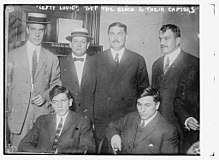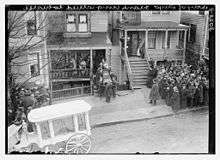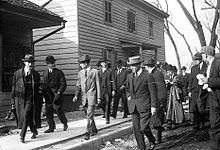Rosenthal murder case
The Becker–Rosenthal trial was a 1912 trial in New York City for the murder of Herman Rosenthal, a bookmaker, by NYPD Lieutenant Charles Becker and members of the Lenox Avenue Gang.[1] The trial ran from October 7 to October 30, 1912, and restarted on May 2 to May 22, 1914. Other procedural events took place in 1915.



Five men, including former Lieutenant Becker, were convicted on murder charges and sentenced to death. Each was executed by the state at Sing Sing prison.
History
In July 1912, Lieutenant Charles Becker was named in the New York World as one of three senior police officials involved in the case of Herman Rosenthal, a small-time bookmaker and gambler who had complained to the press that his illegal casinos had been affected by the greed of Becker and his associates. Rosenthal accused the police of demanding a large percentage of his illegal profits as protection in exchange for allowing him to continue to operate.
At 2 am on July 16, two days after the New York World article was published, Rosenthal was murdered on the street after leaving the Hotel Metropole at 147 West 43rd Street, just off Times Square. He was gunned down by men found to be a crew of Jewish gangsters from the Lower East Side. In the aftermath, Manhattan District Attorney Charles S. Whitman, who had made an appointment with Rosenthal before his death, said that he believed the gangsters had committed the murder at Becker's behest.
John J. Reisler, also known as "John the Barber", told the police that he had seen "Bridgey" Webber running away from the crime scene directly after the killing. After he recanted the next week, likely after being threatened by gangsters, he was charged with perjury.[2]
The New York Times and other major newspapers covered the murder investigation for months, with the Times featuring it on the front page, as it led into complex criminal activities. The events were so complex that the New York Police Department recalled 30 detectives from retirement to help investigate and were said "to know most of the gangsters."[2] One of the recalled detectives, Detective Frank Upton, formerly of the "Italian Squad," was instrumental in the July 25, 1912, arrest of "Dago" Frank Cirofici, one of the suspected killers. He and his companion, Regina Gorden (formerly known as "Rose Harris"), were "so stupefied by opium that they offered no objection to their arrests," according to The New York Times.[3] The department then had one of its policewomen, Mary A. Sullivan, go undercover to gain the trust of Gorden. She befriended the woman as well as other girlfriends and wives of the suspects, which helped to break the case.[4]
Defendants
Convicted and sentenced to death
- Charles Becker (1870–1915), NYPD lieutenant charged with ordering the murder and having protected and extorted from illegal gamblers, executed
- Francisco Cirofici (1887–1914), aka Dago Frank, gunman, executed
- Harry Horowitz (1889–1914), aka Gyp the Blood, gunman, executed[1]
- Louis Rosenberg (1891–1914), aka Lefty Louie, gunman, executed[1]
- Jacob Seidenshner (1888–1914), aka Frank Muller and Whitey Lewis, gunman, executed[5]
Other participants in the case
- William Bourke Cockran (1854–1923), one of Becker's defense lawyers[6]
- Martin Thomas Manton (1880–1946), one of Becker's defense lawyers at the trial.[6]
- John B. Johnston, one of Becker's defense lawyers[6]
- Sam Paul (1874–1927), gambler and owner of the club at which police first thought that the murder was planned.
- Jacob A. Rich (1877–1938), also known as Jack Sullivan[7] and Jacob A. Reich, testified for Becker's defense.[8]
- Jack Rose (1875–1947), aka Baldy Rose, gambler and informant who testified against Becker at the trial[9]
- Herman Rosenthal, murdered bookmaker and gambler.[10]
- Sam Schepps (?–1936), also known as Schapps, mob informant who testified against defendants at the trial[11]
- Harry Vallon, mob informant who testified against the defendants at the trial[11]
- Louis William Webber (1877–1936), aka Bridgey Webber, mob informant who testified against the defendants at the trial[11]
- Charles Seymour Whitman (1868–1947), district attorney, elected in 1914 as governor of New York[12]
- Jack Zelig (1888–1912), murdered before he could testify for the prosecution.[13]
In popular culture
- The British writer P.G. Wodehouse wrote a foreword to his novel Psmith Journalist (1914) that noted the Rosenthal case by way of showing how common gang murders in New York were at the time. He did not discuss the complicity of the police.
- In F. Scott Fitzgerald's novel The Great Gatsby (1925), the fictional gambler Meyer Wolfsheim mentions having been present in the Metropole with Rosenthal moments before the latter was murdered.
- The writer Viña Delmar wrote about the murder in her 1968 book 'The Becker Scandal, A Time Remembered.
See also
References
- "Defense Rests After Calling Some of Those Who Saw the Murder of Rosenthal". The New York Times. November 16, 1912. Retrieved November 25, 2010.
Ex-Magistrate Charles G. F. Wahle, counsel for the gunmen "Gyp the Blood" Horowitz, "Lefty Louis" Rosenberg, "Whitey Lewis", and "Dago Frank" Cirofici on trial before Justice Goff and a jury in the Extraordinary Term of the Supreme Court for the murder of Herman Rosenthal, rested the case of the defense at 5 o'clock yesterday afternoon.
(subscription required) - "Murder Witness Recants in Fear". The New York Times. July 25, 1912. p. 1.(subscription required)
- "'Dago' Frank in the Police Net". The New York Times. July 26, 1912. p. 1.(subscription required)
- Mullenbach, Cheryl (2016). Women in Blue : 16 Brave Officers, Forensics Experts, Police Chiefs, and More. Chicago: Chicago Review Press. pp. 55–68. ISBN 978-1613734223. OCLC 920683298 – via Google Books.
- "The People of The State of New York, Respondent, v. Jacob Seidenshner, Frank Cirofici, Louis Rosenberg and Harry Horowitz, Appellants.". Reports of Cases Decided in the Court of Appeals of the State of New York, Volume 210. New York (State) Court of Appeals.
The defendants were named in the indictment as Frank Muller, alias Whitey Louis, alias Whitey Jack, alias Louis Seidenschue, alias Jack Biegel — Frank Cirofici, alias Dago Frank, alias Frank Palmer — Louis Rosenberg, alias Lefty Louie, alias Louis Marks, alias Louis Baker, alias Charles Raymond — Harry Horowitz, alias Gyp the Blood. The birth name of Frank Muller was later found to be Jacob Seidenshner.
- "Becker's Lawyers Plan Final Move. Application for Federal Writ of Habeas Corpus Discussed with Condemned Man's Wife. Letter Received by H. T. Marshall from Judge Bartlett Submitted to Counsel". The New York Times. July 13, 1915. Retrieved December 24, 2010.
Mrs. Charles Becker had a long conference yesterday afternoon with her husband's lawyers, W. Bourke Cockran, Martin T. Manton and John B. Johnston, in relation to final stops in the fight to save her husband from paying the death penalty for the murder of Herman Rosenthal.
(subscription required) - "Dougherty Gets Murder Witness". The New York Times. July 28, 1912. p. 1.(subscription required)
- "Becker Witness Dies In The Bronx. Jacob A. Rich Testified at the Murder Trial as Reich and Defended Police Officer. Former 'King of Newsboys' Did Not Get 'Vindication' Until Summer of 1936". The New York Times. December 25, 1938. Retrieved December 13, 2010.
Jacob A. Rich, who as Jacob Reich or Jack Sullivan was a chief defense witness in the two trials of Police Lieutenant Charles Becker for the murder of Herman Rosenthal, died early yesterday in the Home for Incurables, Third Avenue and 183d Street, the Bronx.
(subscription required) - "Baldy Jack Rose is Dead Here At 72. Police Close File on Rosenthal Murder Case Figure Whose Testimony Doomed Becker". The New York Times. October 9, 1947. Retrieved November 25, 2010.
The Police Department's Bureau of Identification closed its file yesterday on Jacob (Baldy Jack) Rose. The lanky informer in the Herman Rosenthal murder case of 1912 died in Roosevelt Hospital on Saturday of an internal disorder. He was 72 years old.
(subscription required) - "Gambler Who Defied Police Is Shot Dead. Rosenthal Killed in Front of the Hotel Metropole Early This Morning". The New York Times. July 16, 1912. Retrieved August 23, 2011.
Half a dozen men loitered in front of the Hotel Metropole in Forty-third Street close to Times Square shortly before 2 o'clock this morning, as persons frequently loiter in that neighborhood, attracting no attention from the few persons who passed through the street or such policemen as were in the neighborhood. ...
(subscription required) - "Becker Informers Now Ready To Flit. Schepps West for Vaudeville, Webber to Europe, Rose and Vallon Won't Tell". The New York Times. November 21, 1912. Retrieved December 10, 2010.
Becker's Lawyer Serves Notice of Appeal. Sam Schepps, "Bridgey" Webber, Jack Rose, and Harry Vallon, whose stories convicted Charles Becker and the four ...
(subscription required) - "Death Takes Ex-Governor Of New York. Charles S. Whitman, Hanover, Conn., Native Was Elected in 1914". Hartford Courant. Associated Press. March 30, 1947. Retrieved March 22, 2010.
Charles S. Whitman, 78, former governor of New York, died tonight.
(subscription required) - "Becker Trial Today Despite New Murder. Whitman Confident That He Can Convict Lieutenant Without Zelig's Evidence". The New York Times. October 7, 1912. Retrieved August 15, 2012.
The murder on Saturday night of 'Big Jack' Zelig will not delay the trial of Lieut. ... Zelig was one of the State's chief witnesses against Becker ...
(subscription required)
External links
- Rosenthal murder case from the Library of Congress at Flickr Commons